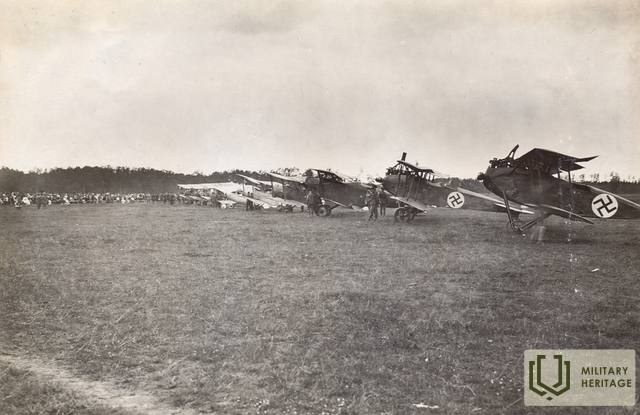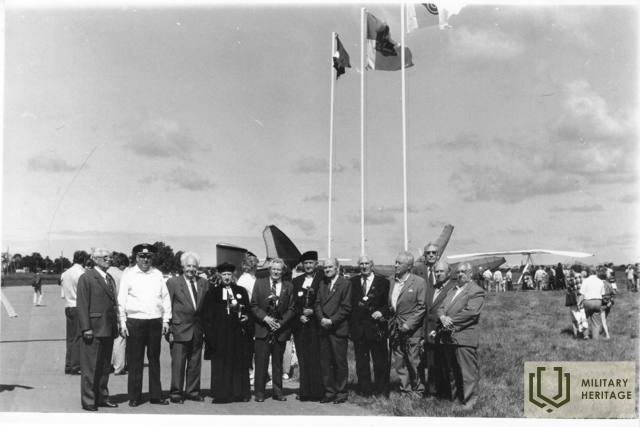Jungtinės aviacijos diena – tikra nacionalinė šventė

Pasakotojas aprašo vieną populiariausių ir gausiausiai lankomų Latvijos renginių – Aviacijos festivalį Spilvėje. Jis apibūdina festivalio eigą ir mastą. Jis pabrėžia aviacijos populiarumą Latvijoje.
„Jungtinė aviacijos šventė – tikra nacionalinė šventė. Mūsų jungtinė aviacija – aviacijos pulkas, gynybos aviacija, civilinės aviacijos entuziastai iš aeroklubo ir jaunimas – sekmadienį susirinko Spilvės aerodrome švęsti kasmetinės aviacijos šventės. Aviacijos šventė metai iš metų tampa vis intensyvesnė, pritraukia vis daugiau lankytojų, todėl ją galima pagrįstai vadinti tikra nacionaline švente. Šis pavadinimas dar tinkamesnis dabar, kai susidomėjimas aviacija mūsų žmonėse įleido labai gilias šaknis, kai sklandytuvai gaminami visuose Latvijos kampeliuose, kai miniatiūriniai lėktuvai jau tapo kiekvieno berniuko mėgstamiausiu žaislu. Todėl sekmadienį Spilvėje vykusią aviacijos šventę galima vadinti tikra nacionaline švente ne tik dėl daugybės dešimčių tūkstančių lankytojų, bet ir dėl to, kad ji suteikia gausių idėjų nacionalinei vienybei, stiprina mūsų šalies gynimo idėją ir suvokimą, kad tik sustiprinę Latvijos gynybines pajėgas galėsime gyventi taikiai ir laimingai mėgautis jų darbo vaisiais mūsų laisvoje Latvijoje.“ (..) Sekmadienį, ankstyvą popietę, žmonės iš visos šalies plūdo į... Spilvė. Rygiečiai ten buvo plukdomi laivais ir baržomis Dauguva, autobusais, privačiais automobiliais ir arklių traukiamomis vežimais, tačiau tie, kurie buvo arčiau namų, eidavo pėsčiomis. Geležinkelio valdyba aviacijos šventei iš Rygos buvo paskyrusi du specialius traukinius, kurie sulaukė daug poilsiautojų Torņame ir Zasulaukoje. Šie perpildyti traukiniai važiavo Rygos–Bolderajos linija, o paskui pasuko geležinkelio atšaka į oro uostą Spilvėje. Taip visa Ryga plūdo į Spilvę. Ir ne tik Ryga, nes tame žmonių sraute, plūstančiame į oro uostą, buvo daug įdegusių kaimo žmonių veidų, ką dar aiškiau liudijo pačių austi sijonai ir paltai. Tvarką palaikė kareiviai ir policininkai, nukreipdami pėsčiuosius viena siauro Bolderajos plento puse, o automobilius – kita. Automobilių stovėjimo aikštelė buvo pilna įvairių transporto priemonių, ir vien žvilgtelėjus į autobusus ir sunkvežimius, iš jų ženklų buvo galima suprasti, kad jie nukeliavo ilgą kelią abiem Dauguvos krantais. Mašinininkai keliavo su visomis atsargomis ir ten sustodavo periodiškai. Geležinkeliai į Rygą iš įvairių miestų taip pat atvežė daug aviacijos festivalio svečių. Specialus turistinis traukinys į Rygą svečius atvežė iš Ventspilio. Taigi du dideli žmonių srautai, nuo Dauguvos ir Rygos-Bolderajos plentu, nepaliaujamai plūdo į vėliavomis išpuoštą Spilvę ir atgal iki vėlaus vakaro. Baltojo dvaro kalvose taip pat buvo tūkstančiai „laisvųjų klausytojų“; ten taip pat buvo galima pamatyti nepakinkytus arklius ir žmones, draugiškomis grupėmis stebinčius šventes iš tolo. Žinoma, daug kas liko nematyta ir neišgirsta, bet vis tiek buvo malonu būti bent arti aviacijos festivalio (..) „(..) Laukiant festivalio svečių aviacijos pulko angaruose, tarptautiniame oro uoste taip pat plevėsavo vėliavos. Aerodrome įspūdinga eile buvo išrikiuoti 37 orlaiviai. Taip pat yra naujas, gražus ir lengvas Liepojos karinio uosto dirbtuvėse pagamintas orlaivis, kuris bus pakrikštytas aviacijos šventėje. Parade taip pat buvo dislokuota priešlėktuvinė artilerija. Prieš pat šventės pradžią informacija transliuojama per garsiakalbius, nes visi šventės svečiai žino viską, ko jiems reikia, neklausdami (..) „(..) Visuomenės dėmesį patraukė bombonešių ataka prieš išties įspūdingą pramonės centrą, pastatytą aerodromo pakraštyje su rūkstančiais kaminais. Suskambus pavojaus sirenoms, „gyventojai“ pasišalino, o tada pradėjo atakuoti bombonešiai. Priešlėktuvinės patrankos griaudėjo, gindamos „miestą“, lėktuvai mėtė „bombas“ ir galiausiai miestas užsidegė. Mūšio įspūdis buvo visiškas. Būtent daina pagimdė Latvijos laisvę laimėtuose mūšiuose. Programos numeriai buvo daug ir įvairūs, o mūsų skiltys per trumpos, kad galėtume juos visus išvardyti ir aprašyti. Kaip ir kiekvienoje didelėje šventėje, kur susirenka dešimtys tūkstančių žmonių (sekmadienį aerodrome jų buvo daugiau nei 50 000). Šventė tęsėsi iki sutemų, o jos pabaigoje karo ministras generolas Balodis per garsiakalbį padėkojo karo lakūnams, gvardijai ir civilinei aviacijai už jų pasiekimus. Pasibaigus šventės programai, kaip ir dera nacionalinei šventei, vyko fejerverkai ir šokiai. Ministro Pirmininko auka. Ministras Pirmininkas dr. K. Ulmanis paaukojo 100 latų aviacijos festivalio lėšų rinkimo akcijai. Tikimasi, kad aviacijos festivalio lėšų rinkimo akcija bus gana didelė (..)“
laikraštis „Latvijas Kareivis“, Nr. 205, 1935 m. Straipsnio antraštė „Jungtinė aviacijos šventė – tikra nacionalinė šventė“
Susijusi laiko juosta
Susijusios vietos
Pagalvės oro uostas
Įsikūręs Rygoje, Pārdaugavoje, Spilvės pievose netoli Iļģuciems.
Spilvė karinio paveldo istorijoje garsėja grandioziniu Spilvės mūšiu XVIII a. ir Spilvės aerodromu. Nuo XX a. ji buvo naudojama lėktuvams bandyti, tačiau Pirmojo pasaulinio karo metu tapo Latvijos aviacijos istorijos liudininku.
Pirmojo pasaulinio karo metu Spilvės pievas Rusijos armijos oro pajėgos naudojo kovai su Vokietijos armija. Sukūrus Latviją, aerodromas tapo svarbiausia šalies oro pajėgų baze ir pilotų mokymo aikštele. Ankstesni aerodromo pavadinimai buvo „Spilvės oro uostas“ arba „Rygos oro uostas“, vėliau „Rygos centrinis oro uostas“. Tai buvo pagrindinis Latvijos oro uostas iki „Rygos“ oro uosto atidarymo 1975 m.
Galbūt Spilvės aerodromas netoli Rygos ir svajonė siekti žvaigždžių prisidėjo prie įspūdingų daugelio Latvijos pilotų pasiekimų. Tačiau galbūt Latvijos aviacijos pradžia yra daug senesnė ir siekia Priekulę, kur latvių kalvis Zviedris savadarbiu prietaisu atliko skrydį iš bažnyčios bokšto.
Šiandien Spilvės aerodromas veikia vis dar. Galima pamatyti 1954 m. pastatytą oro uosto pastatą, kuris įkūnija sovietinį klasicizmą arba „Stalino imperijos“ stilių.
Šaltiniai:
Irbītis, K. Latvijos aviacija ir jos pradininkai. Ryga: Zinātne, 2004 m.
Brūvelis, E. Latvijos aviacijos istorija: 1919-1940. Ryga: Zinātne, 2003 m.
Oficiali valstybinės agentūros „Civilinės aviacijos agentūra“ svetainė. Prieiga per internetą: https://www.caa.gov.lv/lv/latvijas-aviacijas-vesture-isuma [žiūrėta 2021-02-22].






